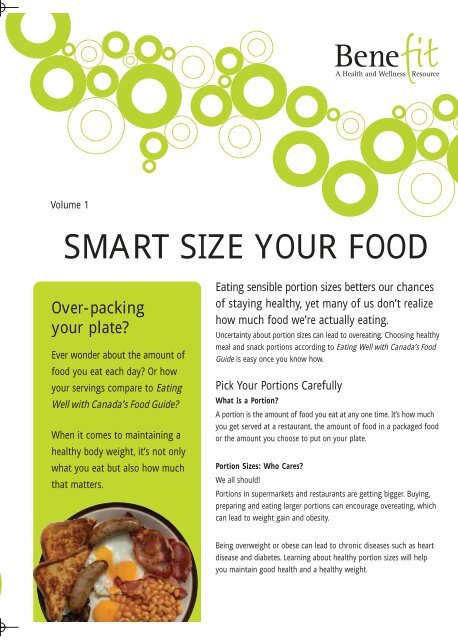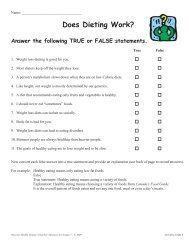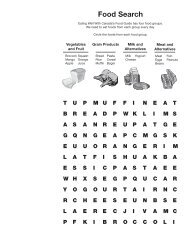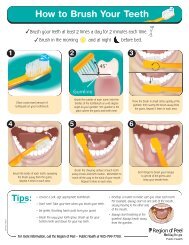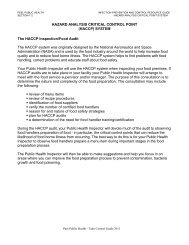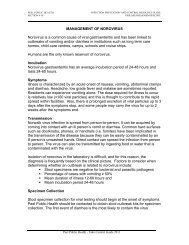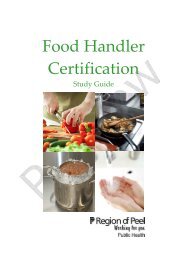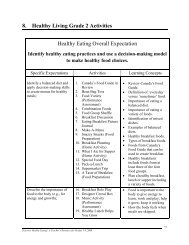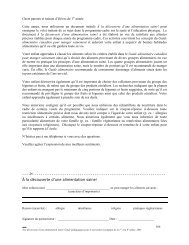Smart Size your Food (277KB, 4 pages) - Region of Peel
Smart Size your Food (277KB, 4 pages) - Region of Peel
Smart Size your Food (277KB, 4 pages) - Region of Peel
You also want an ePaper? Increase the reach of your titles
YUMPU automatically turns print PDFs into web optimized ePapers that Google loves.
Volume 1<br />
SMART SIZE YOUR FOOD<br />
Over-packing<br />
<strong>your</strong> plate?<br />
Ever wonder about the amount <strong>of</strong><br />
food you eat each day? Or how<br />
<strong>your</strong> servings compare to Eating<br />
Well with Canada’s <strong>Food</strong> Guide?<br />
When it comes to maintaining a<br />
healthy body weight, it’s not only<br />
what you eat but also how much<br />
that matters.<br />
Eating sensible portion sizes betters our chances<br />
<strong>of</strong> staying healthy, yet many <strong>of</strong> us don’t realize<br />
how much food we’re actually eating.<br />
Uncertainty about portion sizes can lead to overeating. Choosing healthy<br />
meal and snack portions according to Eating Well with Canada’s <strong>Food</strong><br />
Guide is easy once you know how.<br />
Pick Your Portions Carefully<br />
What Is a Portion?<br />
A portion is the amount <strong>of</strong> food you eat at any one time. It’s how much<br />
you get served at a restaurant, the amount <strong>of</strong> food in a packaged food<br />
or the amount you choose to put on <strong>your</strong> plate.<br />
Portion <strong>Size</strong>s: Who Cares?<br />
We all should!<br />
Portions in supermarkets and restaurants are getting bigger. Buying,<br />
preparing and eating larger portions can encourage overeating, which<br />
can lead to weight gain and obesity.<br />
Being overweight or obese can lead to chronic diseases such as heart<br />
disease and diabetes. Learning about healthy portion sizes will help<br />
you maintain good health and a healthy weight.
Benefit:Layout 1 5/1/08 2:38 PM Page 2<br />
<strong>Size</strong> Up Your Servings<br />
What Is a Nutrition Facts Serving?<br />
A Nutrition Facts serving is the food amount shown at the top<br />
<strong>of</strong> the Nutrition Facts table on packaged foods.<br />
A Nutrition Facts serving is shown<br />
in two ways: as a household measure<br />
(such as cups, tablespoons or slices)<br />
and as a metric measure (such as mL<br />
or g). These measures let you compare<br />
serving sizes to the portions you would<br />
normally eat.<br />
What Is a <strong>Food</strong> Guide Serving?<br />
A <strong>Food</strong> Guide Serving is a measured amount <strong>of</strong> food set by<br />
Health Canada. <strong>Food</strong> Guide servings are shown in Eating Well<br />
with Canada’s <strong>Food</strong> Guide. Examples <strong>of</strong> <strong>Food</strong> Guide Servings<br />
include:<br />
• 250 mL (1 cup) raw leafy vegetables<br />
• 125 mL (1/2 cup) cooked pasta<br />
• 250 mL (1 cup) milk<br />
• 2 eggs<br />
The <strong>Food</strong> Guide tells you how many <strong>Food</strong> Guide Servings you<br />
need from each <strong>of</strong> the four food groups every day.<br />
The Nutrition Facts serving is not a<br />
recommended serving size. It might<br />
not be the same as the suggested<br />
serving size in Eating Well with Canada’s <strong>Food</strong> Guide, but it<br />
can still be used to manage <strong>your</strong> portions.<br />
For example, a female aged 19-50 needs:<br />
• 7-8 <strong>Food</strong> Guide Servings <strong>of</strong> Vegetables and Fruit<br />
• 6-7 <strong>Food</strong> Guide Servings <strong>of</strong> Grain Products<br />
• 2 <strong>Food</strong> Guide Servings <strong>of</strong> Milk and Alternatives<br />
• 2 <strong>Food</strong> Guide Servings <strong>of</strong> Meat and Alternatives<br />
Picture Your <strong>Food</strong> Guide Servings<br />
These everday objects can help you remember<br />
<strong>Food</strong> Guide Servings:<br />
Following Eating Well with Canada’s <strong>Food</strong> Guide will help you<br />
manage <strong>your</strong> portions. Check the <strong>Food</strong> Guide to see how many<br />
servings you should be eating each day.<br />
<strong>Food</strong> Group One <strong>Food</strong> Guide Serving <strong>of</strong>… Looks Like…<br />
Vegetables and Fruit<br />
1 medium vegetable or fruit<br />
125 mL (1/2 cup) fresh, frozen or canned vegetables or fruit<br />
250 mL (1 cup) leafy raw vegetables or salad<br />
1 medium baked potato<br />
a tennis ball<br />
a standard computer mouse<br />
a baseball<br />
a standard computer mouse<br />
Grain Products<br />
½ bagel (45 g)<br />
125 mL (½ cup) rice or pasta, cooked<br />
slice <strong>of</strong> bread<br />
175 mL (¾ cup) hot cereal<br />
a hockey puck<br />
a standard computer mouse<br />
a compact disc case<br />
a tennis ball<br />
Milk and Alternatives<br />
1 ½ oz (50 g) <strong>of</strong> block cheese<br />
175 g (3/4 cup) yogurt<br />
250 mL (1 cup) milk<br />
six dice<br />
a 175 g single serve yogurt container<br />
a 250 mL single serve carton<br />
Meat and Alternatives<br />
2 ½ oz (75 g) meat, fish or poultry, cooked<br />
30 mL (2 tbsp) peanut or nut butter<br />
175 mL (¾ cup) legumes, cooked<br />
a deck <strong>of</strong> cards (a little smaller than)<br />
a golf ball<br />
a tennis ball
Portion Your Plate<br />
<strong>Smart</strong> <strong>Size</strong> It!<br />
Managing Your Portion <strong>Size</strong>s<br />
Use these tips to control <strong>your</strong> portion<br />
sizes while eating out or at home.<br />
Eating Out<br />
• Skip the super-size option.<br />
Choose smaller “smart size”<br />
portions instead.<br />
• Ask for a half portion or save half<br />
for lunch the next day.<br />
• Share dessert with a friend.<br />
Create a healthy balanced meal by dividing <strong>your</strong> plate<br />
into three sections:<br />
1. Half (½) <strong>of</strong> <strong>your</strong> plate should be vegetables and fruit<br />
(such as carrots and broccoli).<br />
2. One quarter (¼) should be grains (such as whole grain<br />
pasta or rice).<br />
3. One quarter (¼) should be meat and alternatives<br />
(such as chicken or beans).<br />
Enjoy <strong>your</strong> meal with a glass <strong>of</strong> milk.<br />
Eating at Home<br />
• Eat only when you’re hungry<br />
and stop eating before you feel full.<br />
• Don’t skip meals. (Skipping meals can<br />
lead to overeating later on in the day.)<br />
• Eat a healthy snack between meals to<br />
avoid overeating at mealtimes.<br />
• Don’t eat while watching television.<br />
(You’ll pay less attention to how much<br />
you’re eating if you’re watching TV.)<br />
• Put smaller portions <strong>of</strong> treats (such as ice<br />
cream or potato chips) in a bowl instead<br />
<strong>of</strong> eating out <strong>of</strong> the container or bag.<br />
• Serve food on smaller plates and in<br />
smaller bowls.<br />
• Serve healthy portions on individual plates<br />
instead <strong>of</strong> putting serving dishes on the table.<br />
• Read food labels. Compare how much you eat<br />
to the Nutrition Facts serving size.<br />
• Learn to recognize <strong>Food</strong> Guide Servings. Compare<br />
what you normally eat to Eating Well with<br />
Canada’s <strong>Food</strong> Guide.<br />
Choose a medium-sized plate (about the<br />
size <strong>of</strong> a Frisbee®) to help you keep <strong>your</strong><br />
portions healthy.
Benefit:Layout 1 5/1/08 2:38 PM Page 1<br />
Did You Know...<br />
• A plate <strong>of</strong> pasta may equal three to four <strong>Food</strong> Guide<br />
Servings <strong>of</strong> Grain Products.<br />
• A 591 mL bottle <strong>of</strong> 100% juice equals almost<br />
five <strong>Food</strong> Guide Servings <strong>of</strong> Vegetables and Fruit.<br />
(Get most <strong>of</strong> <strong>your</strong> Vegetable and Fruit servings by<br />
eating whole vegetables and fruit. They contain more<br />
fibre and other valuable nutrients than juice.)<br />
227g (8oz) Steak<br />
75g (2.5oz) Steak<br />
= 1 <strong>Food</strong> Guide Serving<br />
• A large bagel may equal three to four <strong>Food</strong> Guide<br />
Servings <strong>of</strong> Grain Products.<br />
• An 227g (8oz) steak equals three <strong>Food</strong> Guide<br />
Servings <strong>of</strong> Meat and Alternatives.<br />
• A 6-inch submarine bun equals two to three<br />
<strong>Food</strong> Guide Servings <strong>of</strong> Grain Products.<br />
Try This!<br />
1. Pour the amount <strong>of</strong> cereal you would normally<br />
eat into a bowl.<br />
2. Measure and compare <strong>your</strong> amount against the serving<br />
size listed on the cereal box’s Nutrition Facts table.<br />
Are you eating more or less? How many <strong>Food</strong> Guide<br />
Servings are you eating? Try this activity with other<br />
foods you enjoy.<br />
Remember that the nutrition information is based on<br />
the serving size stated in the Nutrition Facts table<br />
and could be different from the amount you eat.<br />
Produced by Public Health Nutritionists and Dietitians in the <strong>Region</strong> <strong>of</strong> <strong>Peel</strong>.<br />
May be reproduced without permission provided source is acknowledged. For more nutrition information,<br />
please call the <strong>Region</strong> <strong>of</strong> <strong>Peel</strong> – Public Health at 905-799-7700.<br />
B-07-160 08/02


